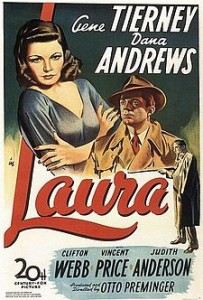Laura (1944 film)
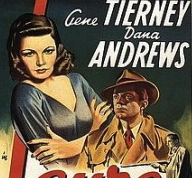
Laura (1944) – She Had Something About Her
Early in his debriefing of cop McPherson (Dana Andrews) about his relationship with the victim, prissy columnist Waldo Lydecker (Clifton Webb) describes his first meeting with the murdered title character (Gene Tierney), her first appearance on screen, in Otto Preminger’s “Laura,” 1944.
Laura is a 1944 American film noir produced and directed by Otto Preminger. It stars Gene Tierney, Dana Andrews, and Clifton Webb along with Vincent Price and Judith Anderson. The screenplay by Jay Dratler, Samuel Hoffenstein, and Betty Reinhardt is based on the 1943 novel of the same title by Vera Caspary.
Plot
New York City police detective Mark McPherson (Dana Andrews) is investigating the murder of beautiful and highly successful advertising executive, Laura Hunt (Gene Tierney). Laura has been killed by a shotgun blast to the face, just inside the doorway to her apartment, before the start of the film. He interviews charismatic newspaper columnist Waldo Lydecker (Clifton Webb), an imperious, decadent dandy, who relates how he met Laura, became her mentor, and used his considerable influence and fame to advance her career. McPherson also questions Laura’s parasitic playboy fiancé, Shelby Carpenter (Vincent Price), her wealthy socialite aunt, Ann Treadwell (Judith Anderson), who’d been carrying on with Carpenter and giving him money, and her loyal housekeeper, Bessie Clary (Dorothy Adams).
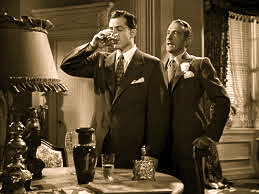 Through the testimony of her friends, and the reading of her letters and diary, McPherson comes to know Laura and slowly becomes obsessed with her, so much so Lydecker accuses him of falling in love with the dead woman. He also learns that Lydecker was jealous of Laura’s suitors, using his newspaper column and influence to keep them at bay.
Through the testimony of her friends, and the reading of her letters and diary, McPherson comes to know Laura and slowly becomes obsessed with her, so much so Lydecker accuses him of falling in love with the dead woman. He also learns that Lydecker was jealous of Laura’s suitors, using his newspaper column and influence to keep them at bay.
One night, the detective falls asleep in Laura’s apartment, under her portrait, and is awakened by the sound of someone entering the apartment. He is shocked to discover it is Laura. Laura finds a dress in her closet belonging to one of her models, Diane Redfern. McPherson concludes that she, Diane Redfern, was the victim, brought there by Carpenter, while Laura was away in the country. Now it becomes even more urgent to unmask the murderer.
A party is thrown to welcome Laura’s return. At the party, McPherson arrests Laura for the murder of Diane Redfern. Upon questioning her, he is convinced of her innocence and that she does not love Shelby. He returns her to her apartment, and then goes to search Lydecker’s apartment. There he becomes suspicious of a clock that is identical to the one in Laura’s apartment. On closer examination he finds a secret compartment.
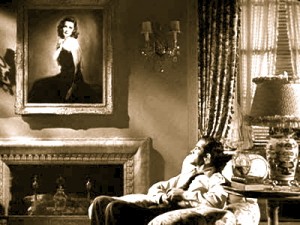 McPherson returns to Laura’s apartment. Lydecker is there and it is apparent there is a growing bond between Laura and the detective. Lydecker insults McPherson and is sent away by Laura but pauses on the stairwell outside. After Lydecker has left, McPherson examines Laura’s clock and finds the shotgun that killed Diane. Laura is confronted with the truth that Lydecker was the murderer. McPherson locks Laura in to her apartment, warning her not to let any one in. After he has left, Lydecker emerges from another room and attempts to kill Laura, claiming if he cannot have her, no one can. He is shot down by McPherson’s sergeant, who had told McPherson that Lydecker had never left the building, causing the two policemen to return to the apartment. Lydecker’s last words are: “Goodbye, Laura. Goodbye, my love.”
McPherson returns to Laura’s apartment. Lydecker is there and it is apparent there is a growing bond between Laura and the detective. Lydecker insults McPherson and is sent away by Laura but pauses on the stairwell outside. After Lydecker has left, McPherson examines Laura’s clock and finds the shotgun that killed Diane. Laura is confronted with the truth that Lydecker was the murderer. McPherson locks Laura in to her apartment, warning her not to let any one in. After he has left, Lydecker emerges from another room and attempts to kill Laura, claiming if he cannot have her, no one can. He is shot down by McPherson’s sergeant, who had told McPherson that Lydecker had never left the building, causing the two policemen to return to the apartment. Lydecker’s last words are: “Goodbye, Laura. Goodbye, my love.”
Cast
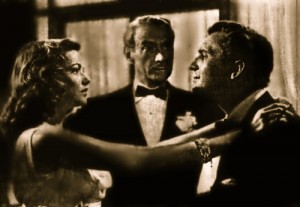 Gene Tierney as Laura Hunt
Gene Tierney as Laura Hunt
Dana Andrews as Mark McPherson
Clifton Webb as Waldo Lydecker
Vincent Price as Shelby Carpenter
Judith Anderson as Ann Treadwell
Production
Otto Preminger was looking for a theatrical project to direct and first became aware of Vera Caspary’s story when her agent offered him the first draft of a play called Ring Twice for Laura. Preminger liked the high-society setting and the unusual plot twist but felt the work needed a major revision and offered to rewrite it with its author. He and Caspary disagreed about the direction they should take it and she opted to collaborate with writer George Sklar instead. Marlene Dietrich expressed interest in portraying the title character, but without the attachment of Dietrich or another major star, Caspary was unable to find a producer willing to finance a national tour or a Broadway run, and she abandoned the project.
Caspary eventually adapted the play for a novel with the same title and a sequel entitled simply Laura, both of which eventually were purchased by 20th Century Fox for $30,000. George Sanders and Laird Cregar were announced as the leads.
Interim studio head William Goetz, serving in that capacity while Darryl F. Zanuck was fulfilling his military duty, assigned Preminger the task of developing the books for the screen, and he began working with Jay Dratler, Samuel Hoffenstein, and Betty Reinhardt. Recalling the differences of opinion he and Caspary had had, Preminger opted not to involve her until the first draft was completed. He sensed the more interesting character was not Laura but Waldo Lydecker and expanded his role accordingly, but Caspary was unhappy with the changes to her plot.
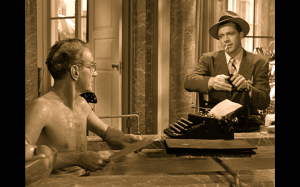 Zanuck, with whom Preminger previously had clashed, returned to the studio and was angered to discover Goetz had rehired his nemesis. In retaliation, he announced Preminger could produce but not direct Laura and assigned him to helm In the Meantime, Darling instead. Several directors, including Lewis Milestone, were offered and rejected Laura until Rouben Mamoulian finally agreed to direct. Mamoulian immediately ignored all of Preminger’s directives as producer and began to rewrite the script. To Preminger’s dismay, he cast Laird Cregar, known for his portrayal of Jack the Ripper in The Lodger, in the key role of Lydecker. The producer felt casting an actor with a reputation for playing sinister roles would lead the audience to become suspicious of Lydecker earlier than necessary. He favored Clifton Webb, who had left films in 1930 to concentrate on the stage and at that time was appearing in the Noël Coward play Blithe Spirit in Los Angeles. Fox casting director Rufus LeMaire and Zanuck both objected to Webb because of his overt effeminate mannerisms, exactly what Preminger felt suited the character. He filmed the actor delivering a monologue from the Coward play, and Zanuck agreed he was perfect for the role. Zanuck was similarly campaigning for actor Reginald Gardiner to play the role of Shelby, though Fox contractee Vincent Price finally got the role.
Zanuck, with whom Preminger previously had clashed, returned to the studio and was angered to discover Goetz had rehired his nemesis. In retaliation, he announced Preminger could produce but not direct Laura and assigned him to helm In the Meantime, Darling instead. Several directors, including Lewis Milestone, were offered and rejected Laura until Rouben Mamoulian finally agreed to direct. Mamoulian immediately ignored all of Preminger’s directives as producer and began to rewrite the script. To Preminger’s dismay, he cast Laird Cregar, known for his portrayal of Jack the Ripper in The Lodger, in the key role of Lydecker. The producer felt casting an actor with a reputation for playing sinister roles would lead the audience to become suspicious of Lydecker earlier than necessary. He favored Clifton Webb, who had left films in 1930 to concentrate on the stage and at that time was appearing in the Noël Coward play Blithe Spirit in Los Angeles. Fox casting director Rufus LeMaire and Zanuck both objected to Webb because of his overt effeminate mannerisms, exactly what Preminger felt suited the character. He filmed the actor delivering a monologue from the Coward play, and Zanuck agreed he was perfect for the role. Zanuck was similarly campaigning for actor Reginald Gardiner to play the role of Shelby, though Fox contractee Vincent Price finally got the role.
Filming began on April 27, 1944, and from the start Mamoulian had problems with his cast. He offered relative newcomers Gene Tierney and Dana Andrews little support, allowed theatrically trained Judith Anderson to play to the balcony instead of reining in her performance, and virtually ignored Webb, who had learned the director was unhappy with his casting. After viewing the early rushes, Zanuck called a meeting with Mamoulian and Preminger, each of whom blamed the other for the problems on the set. Preminger finally convinced Zanuck the material needed a more subtle approach than Mamoulian was willing to give it, and the studio head allowed the producer to fire him and direct the film himself. Preminger immediately hired a new cinematographer and scenic designer and replaced the portrait of Laura – a crucial element of the film; Mamoulian’s wife Azadia had painted the original portrait, but Preminger replaced that with an enlarged photograph (taken by Fox photographer Frank Polony) of Tierney, lightly dabbed with oils to give it the ethereal effect he wanted.
Preminger initially experienced resistance from his cast, who had been led to believe Preminger was unhappy with their work by the departing Mamoulian. “Once we got used to Otto, we had a pretty easy time,” Vincent Price recalled in a July 1989 interview. Filming was completed on June 29, slightly over budget but within the projected timetable.
Zanuck was unhappy with Preminger’s first cut of the film and insisted it be given a new ending, in which it was revealed Lydecker had imagined the entire story. Following a screening of the Zanuck version, columnist Walter Winchell approached the studio head and told him, “I didn’t get [the ending]. You’ve got to change it.” Zanuck relented and allowed Preminger to reinstate his original finale, telling him, “This is your success. I concede.”
Music
 Once principal photography was completed, Preminger hired David Raksin to score the film. The director wanted to use “Sophisticated Lady” by Duke Ellington for the main theme, but Raksin objected to the choice. Alfred Newman, music director for Fox, convinced Preminger to give Raksin a weekend to compose an original tune. Inspired by a Dear John letter he had received from his girlfriend, Raksin wrote the haunting theme for which Johnny Mercer later wrote lyrics. It eventually became a jazz standard recorded by more than four hundred artists, including Stan Kenton, Dick Haymes, Woody Herman, Nat King Cole, The Four Freshmen, Charlie Parker, and Frank Sinatra. Even Spike Jones did a parody version of the song. Preminger was so pleased with Raksin’s score the two collaborated on four additional films. (refer to “Laura (1945 song).”
Once principal photography was completed, Preminger hired David Raksin to score the film. The director wanted to use “Sophisticated Lady” by Duke Ellington for the main theme, but Raksin objected to the choice. Alfred Newman, music director for Fox, convinced Preminger to give Raksin a weekend to compose an original tune. Inspired by a Dear John letter he had received from his girlfriend, Raksin wrote the haunting theme for which Johnny Mercer later wrote lyrics. It eventually became a jazz standard recorded by more than four hundred artists, including Stan Kenton, Dick Haymes, Woody Herman, Nat King Cole, The Four Freshmen, Charlie Parker, and Frank Sinatra. Even Spike Jones did a parody version of the song. Preminger was so pleased with Raksin’s score the two collaborated on four additional films. (refer to “Laura (1945 song).”
Soundtrack
In 1993 Fox Records released a 27-minute suite of Raksin’s score on an album paired with Bernard Herrmann’s score for Jane Eyre. In 2013 Kritzerland released the complete Raksin score along with test demos and the suite from the original album as bonus tracks.
Track listing:
Main Title (02:18)
The Phonograph (00:25)
The Café (04:06)
Waldo Walks Away (01:01)
Theatre Lobby (01:27)
Night (03:05)
The Café/Waldo’s Apartment (04:14)
Laura Leaves (00:59)
The Portrait (03:23)
Mark (01:05)
Apartment House (01:21)
Radio (01:24)
The Party (03:41)
Outside Waldo’s Door (01:27)
Waldo (04:30)
End Title (01:23)
Laura Theme – Test Demos (01:44)
The Laura Suite – Theme and Variations (27:20)

